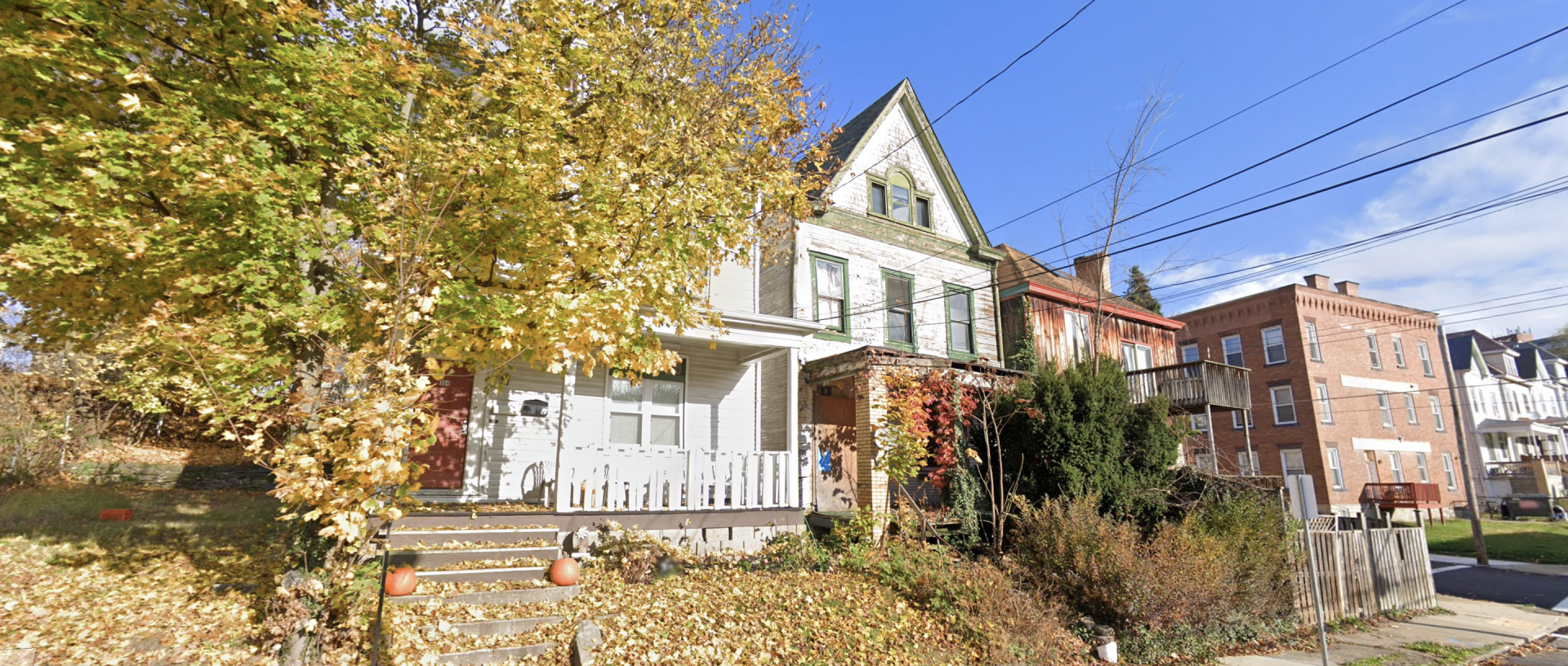
The City of Pittsburgh has owned this condemned house at 302 W. Burgess St. in Pittsburgh since 2017.

The City of Pittsburgh has owned this condemned house at 302 W. Burgess St. in Pittsburgh since 2017.

Google Maps
The City of Pittsburgh has owned this condemned house at 302 W. Burgess St. in Pittsburgh since 2017.
(Pittsburgh) — Mayor Bill Peduto is signing an executive order today to create an alternative to mechanically knocking down condemned structures. Instead, the city will pilot “deconstruction,” a process in which buildings are taken apart bit by bit.
Rather than rolling into a neighborhood and blasting a home apart, Peduto said by carefully undoing the structures, crews can respect the craftsmanship of the people who built these homes. He added the process keeps harmful substances like lead and asbestos out of the air and soil. But he said the most exciting component of the new initiative is job creation.
“We could be employing people from the neighborhoods to become deconstruction experts,” he said prior to a signing event Tuesday afternoon.
Deconstruction can be a costlier and more time-consuming process than swinging a wrecking ball, but Peduto said that the long-term benefits make it a win.
It will be some time before the city uses the approach: Officials hope to identify 10 houses that are good candidates for deconstruction by the fall. But committing to the idea, and communicating its advantages, is an important step, said Mike Gable, who leads the nonprofit Construction Junction.
“The main goal is to make sure that usable material isn’t going to a landfill,” he said, noting that the cleaner the material, the more likely it can be salvaged and made available for the next project. Even if it can’t be reused, it can be recycled.
“We have to start thinking about the waste stream … as a value stream,” Gable said.
Some 1,700 buildings across Pittsburgh are condemned as uninhabitable, and the city owns roughly 20 percent of them. Since 2015, the city has spent $12 million on demolition and issued more than double that amount in permits to private contractors. While private-sector activity dwarfs city-funded work, PLI Director Sara Kinter said that’s precisely why the city wants to take the lead on deconstruction.
“There are a lot of open questions” about how deconstruction stacks up against demolition, she said. If the city can provide that information to contractors and make it more appealing, “We can start opening up those avenues to have a more sustainable demolition and deconstruction approach in the city from everyone.”
Vacant structures are a maddening problem for the people who live around them, said Jessica Rohe-Cook, a 311 response line representative.
“Neglected properties start these bigger issues,” she said, noting a common tipping point is people who call about rat and raccoon infestations. Rohe-Cook estimates she gets at least one call a day about an abandoned house, and doesn’t have very good answers to offer people.
“I learned pretty quickly about our demolition budget and the constraints we face trying to get condemned buildings taken care of,” she said. “A lot of the conversations … are ones where I’m not really delivering good news.”
The Department of Permits, Licenses and Inspections, or PLI, is responsible for demolition of condemned properties. Traditionally, PLI has prioritized emergency demolitions, tearing down houses that threaten safety. But city operations assistant Alicia Carberry said structures that aren’t an imminent danger still hurt people living nearby.
Residents in such areas can experience “increases in blood pressure rates, in depression rates, and just general feelings of hopelessness caused by living on a block with abandoned homes,” she said, citing research that was conducted partly in Homewood.
Carberry said under the executive order, the Department of Finance will work with other city agencies to convert lots into beneficial community uses. The city’s deconstruction initiative prioritizes communication with residents about the values of deconstruction and how community members can get involved.
Beyond potential job creation, Carberry said the city wants to time deconstruction with helping neighborhoods decide what they want to see on a newly empty lot.
“That could include adopting a lot to make it a community garden or an orchard or some sort of passive green space,” she said.
Peduto agreed, and said some cities that have had mass demolition projects, “it really didn’t remove blight,” he said. “It just replaced one type of blight with housing into another type of blight with unkept lots.”
By contrast, deconstruction policies are already on the books in places such as Sarasota, FL, San Antonio, TX, and Seattle, WA.

Get insights into WITF’s newsroom and an invitation to join in the pursuit of trustworthy journalism.
The days of journalism’s one-way street of simply producing stories for the public have long been over. Now, it’s time to find better ways to interact with you and ensure we meet your high standards of what a credible media organization should be.